Edited 7/10/07 to add link to the full OHS article at the end in Additional Resources.
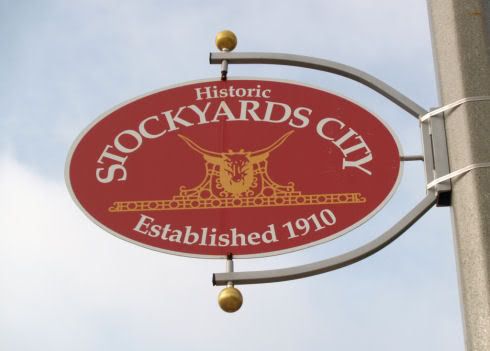
... says Stockyards City (formerly known as Packingtown)!
According to a May 8, 1994, Oklahoman article by Jon Denton,
You know you're in Stockyards City when:This post traces the history, present day, and prospects for Stockyard City.There are more real cowboys on the street than in all the rest of Oklahoma city Everywhere you look, there's a store with Western boots, saddles, jeans or hats There's a beefy aroma in the air, but it's not even close to what you get at McDonald's.
Greenhorns might say Stockyards City, south of Interstate 40 and west of downtown, has authentic "Western ambience."
* * *
It's the cowboys who have never given up on Stockyards City. The town-within-a-town got started when packing plants and feed lots opened on the far southwest edge of town just after the turn of the century.
Into the 1930s, the cowboys, farmers and ranchers made Stockyards City a destination point for their livestock sales and weekend shopping. They bought their farm implements, building materials and clothing, and they patronized the bankers and doctors.
They sated some hearty appetites with some of the best Western-style restaurants in the state. And sometimes they got in trouble.
"There were a lot of rowdy bars and old hotels that doubled as other things," [Chris] Wilson says. "I would say right around Prohibition was the town's high point, with gambling and wide-open liquor.
"There are a lot of stories, but I think it's pretty well known that a pastor and sheriff were both bootleggers."
While visitors do not find the bars and hotels they did 50 years ago, the merchants wisely leave the Western flavor unchanged.
They might bristle, however, at the suggestion they offer any sort of Western theme-town experience. They operate at a profit. They remain individualists. They say they are typical of those who settled the West, one hand on the plow and the other hand on a gun.
WHERE IS IT? Stockyards City is generally a 4-6 block area centering on the intersections of Exchange and Agnew Avenues, with SW 15th and SW 11th as the respective southern and northern boundaries. The Oklahoma City National Stockyards is immediately west and north, and the former Wilson & Co. and Armour & Co. meat packing plants were to the area's west, just east of May Avenue. They all form part of the area's history and identity. Many thanks to mmm at OkcTalk.com for getting my head straight on the maps below and the relative locations of Armour & Wilson ...
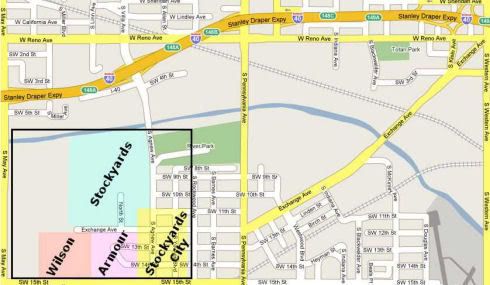
A closer look at the area is shown below:
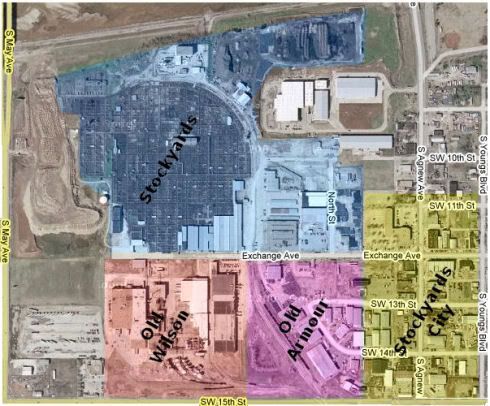
EARLY ENVIRONS. Sorry, vegetarians, but Oklahoma City had some of its early economic underpinnings based on cowboys ... which is to say ... cattle ... which is to say, "beef." In the days before Stockyards City, cattle would be driven to Oklahoma City and loaded on trains bound for Kansas City or Chicago as is nicely discussed by Larry Johnson in his article at the Oklahoma City Metropolitan Library System (you may need to click your "refresh button" to load the article after clicking the previous link). His article opines that this pic, taken in 1891, shows longhorns on Grand Ave., looking west from the Santa Fe Railroad.

But, some or all of that would change in 1910 when the local Chamber of Commerce (or its predecessor's name) succeeded in luring Chicago's Morris & Co. (to become Armour & Co.) to build a $3 million slaughterhouse and meat packing plant here. Another fine article, Oklahoma City National Stockyards and the Packing Industry, by Larry Johnson at the Metropolitan Library System (again, you may have to click your refresh button after clicking the prior link – that often seems to be the case with links to the "Oklahoma Images" articles in the MLS website). Mr. Johnson's article describes that Thomas E. Wilson had been negotiating "secretly" with city leaders such as Anton Classen since 1908 for this development which included incentives by the city – a cash contribution of $300,000, connections to city utilities and electricity, and an agreement to keep the 200 acre tract involved outside the city limits for five years (i.e., no city taxes).
In fact, some or all of the area remained outside city limits as late as 1988, according to a September 5, 1988, Oklahoman article – I'm uncertain of its "current" status but I'll update this later as I learn more.
The new plant employed 1,000 people and worked hand-in-glove with the next-door Oklahoma National Stockyards Company and, according to Mr. Johnson's article, was an immediate success, so much so that another company, Schwartzschild & Sulzberger (S & S) (to become Wilson & Co.) was built next door, west of Morris & Co. Together, these plants employed 2,400, not to mention the bourgeoning business area which developed to the east which became known as "Stockyards City" (though it was never incorporated as such). Do the math ... 60,000 population ... guessing that 1/3 of the population was "employed" somewhere ... which is 20,000 ... that means that 12% of the working population was employed in the packing plants, not counting collateral employment associated with the meat packer people!
Smelly? Oh, yeah! I remember it when driving to Okc when I was a kid in the late 1950s, driving north on May from Lawton before the interstates were constructed. In fact, the odorific prospects originally projected the area's development northwest of Oklahoma City – though, of course, that did not happen. A November 16, 1987, Oklahoman article quoted Clarence Achgill who began reporting on livestock markets in 1926. He said,
My first impression of the stockyards was, it stunk. * * * That (first impression) lasted in my mind forever, but after a week or two I didn't even smell it.That's good for him, but even not living in Okc in those years, the stinking memory still remains! The only worse smell I remember is from a paper mill in Camden, Arkansas, in 1960 or so! Yuuch! Trust me, the Camden, Ark., "yuuch" is twice as much as Packingtown, but both remain in my serious "yuuch" category!
Vice? For sure! Mr. Johnson's article says,
The work associated with the industry was often grueling, combining long hours with physically demanding work not recommended for the squeamish and the area quickly became known as one of the wilder parts of town as "cowboys" and slaughterhouse workers let off steam. According to Bonnie Speer, "Almost every business sheltered a house of prostitution on the top floor. Nearly everyone was involved in gambling and bootlegging, one way or another."Here are some of the early day images I've located. As is almost always true, click on an image for a larger view.
One of the Stockyards' and the city's most enduring landmarks has its own legend involving gambling. The story goes that the Cattlemen's Restaurant, which also opened in 1910, was owned by Hank Frey who entered into a craps game with Percy Wade in 1945. As the stakes climbed Frey put the keys to the restaurant on the table for collaterl. Frey lost and Percy Wade and his son would operate the restaurant for the next 50 years.
(Abalache Book Shop Publishing 1982)
Morris & Co. 1910
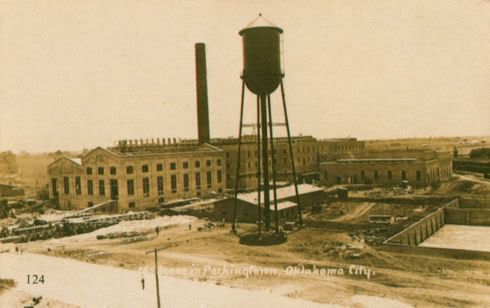
Credit Oklahoma City Metropolitan Library System
Morris & Co. and the new Livestock Exchange Building to the Left

Credit Jim Edwards & Hal Ottaway's Vanished Splendor
(Abalache Book Shop Publishing 1982)
S&S Company
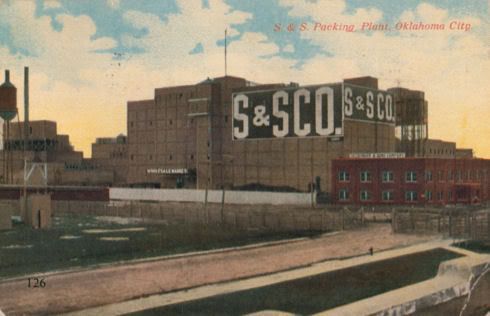
Credit Jim Edwards & Hal Ottaway's Vanished Splendor II
(Abalache Book Shop Publishing 1983)
It Wasn't Just Beef – Hogs (and sheep), Too!
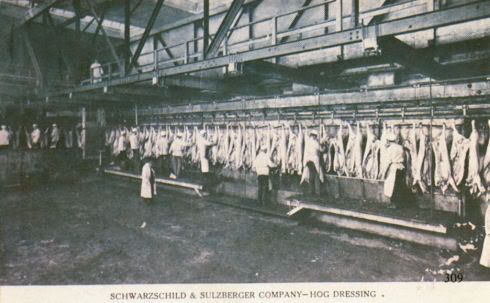
Credit Jim Edwards & Hal Ottaway's Vanished Splendor
(Abalache Book Shop Publishing 1982)
A 1911 Pic Showing Both Plants
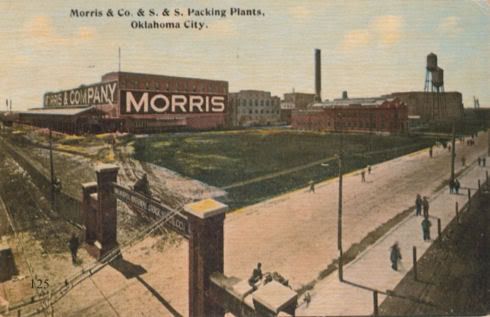
Credit Jim Edwards & Hal Ottaway's Vanished Splendor
(Abalache Book Shop Publishing 1982)
A 1911 Pic Showing Stockyards City and the Stockyard Entry
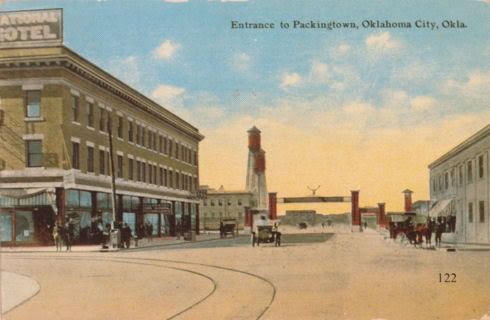
OTHER DEVELOPMENTS. As already said, other developments occurred in and after 1910 as commerce, and recreation, as well, developed. Some are shown in this section.
Livestock Exchange. This building is at the left in the MLS image, above. Constructed in 1910 and located on the north side of Exchange Ave. and inside and west of the Packingtown Gate, it was the business address for a number of firms related to the cattle and packing industry. The original building was destroyed by fire in 1915 and was immediately rebuilt.
(Abalache Book Shop Publishing 1982)
The 1910 Facility
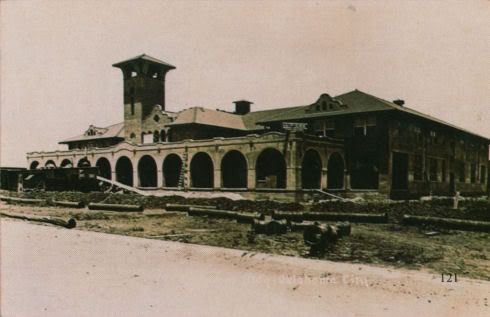
Credit County Assessor's Website
The Successor (larger image not available)
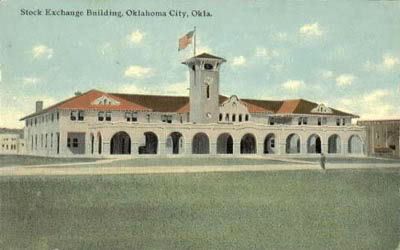
A fire in 1980 destroyed the above and it, too, was replaced by a later building, shown in the contemporary images below.
The Coliseum. The Oklahoma Coliseum opened in 1922. While certainly used in conjunction with the Stockyards and associated events, its use was not as limited as that. As noted in Vanished Splendor, it hosted road-show comedies, auto shows, conventions, and performances by Al Jolson, John Philip Sousa's Band, Jack Dempsey, and others. Destroyed by fire in 1930, it was rebuilt in 1931 and survived until 1970 when it was destroyed (the State Fairgrounds facility had pretty much captured its business – and the fairgrounds facility had air conditioning which the Coliseum did not).
(Abalache Book Shop Publishing 1982)
The 1922 Coliseum
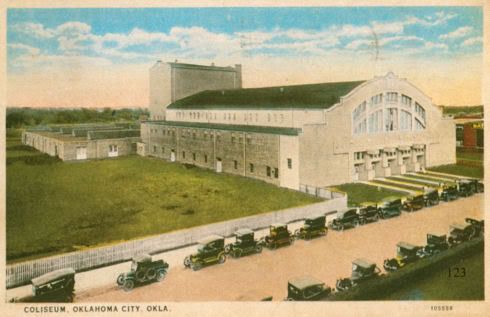
Credit Jim Edwards & Hal Ottaway's Vanished Splendor II
(Abalache Book Shop Publishing 1983)
The 1931 Coliseum
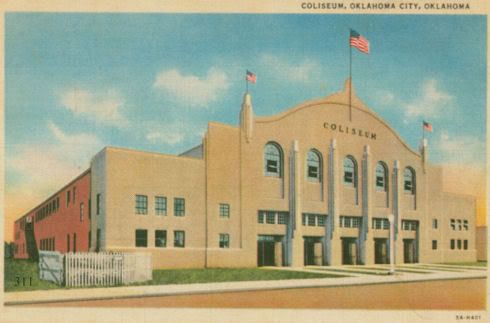
ALL IS WELL IN STOCKYARDS CITY. For many years, all continued to go well and the area flourished, as is reflected in the following images from the 1930s and 1950s.
Even "sin" fared well during this period. A December 17, 1952, Oklahoman article, "Our City Hot? Yes, Frankly – in Spots", responding to a national article which labeled Oklahoma City as a "Hot Town, U.S.A.," said,
Just how wild is Oklahoma City? How "open" are the taprooms generally? Daily Oklahoman reporters after three weeks of investigation are convinced that whisky can be bought along with beer in perhaps 25 percent of them. Some officers concede privately and with candor that the figure may be closer to 50 percent.Hmmm ... see February 9 and 10, 1952, Oklahoman stories if you're interested in pursuing this topic. Before closing this section, it is worth noting that in a February 9, 1952, article, it was reported that:
* * *
You can find what you want in Oklahoma City. In behalf of law enforcement agencies, it can be said that gambling is not "wide open," prostitution flourishes but not flagrantly. There is no "organized crime" in the sense that bigger cities know it * * *.
He [Dwight Brown, OCPD Chief] produced police records to show that Smoke House parlor had been raided 15 times since Nov. 7, 1951, and its operators and players had paid gambling fines totaling $1,056. ¶"That doesn't look to me like he has had very much police protection."In a December 17, 1952, article, it was said ...
The magazine writer claimed, "there are more strippers in Oklahoma City and you see there what you don't see in any other place in the United States."Right. But, what's the truth?
Were the 1952 protestations of City Police and city officials true? Hmmm ... in a September 30, 1953, Oklahoman article, this interesting story appeared:
Officer Denies He Linked City Police, GamlberSo, the city denies the "sin" so ... it doesn't exist. Hooahh!
Walter Acord, one-time Oklahoma City police vice bureau chief and retiring 34-year veteran policeman, toned down his charges against Packingtown's kingpin gambler Tuesday afternoon following conferences with police chief L. J. "Smokey" Hilbert and "two or three" councilmen.
Earlier in the day, Acord told a newsman that gambler Hank Frey "and others" had controlled an element of the city government for the last several years.
* * *
He [Acord] said: "For the last several years an element of the city government has been controlled by Stockyards City gambler Hank Frey and others. I wasn't ready to retire, but working conditions have got so bad at the police department I'm going to."
"Sin" wasn't the only thing allegedly going on in this "mid" period as the area continued to prosper. So, let's get back to that boring stuff.
(Abalache Book Shop Publishing 1983)
Wilson & Co.'s Clydesdales at 1936 State Fair
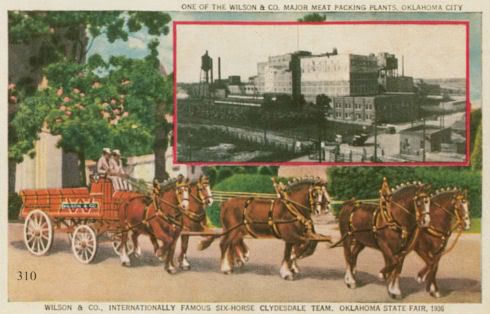
The next two images are in Lucyl Shirk's Oklahoma City, Capital of Soonerland
(Oklahoma City Board of Education 1957)
Bird's Eye Views in Early-To-Mid 1950s

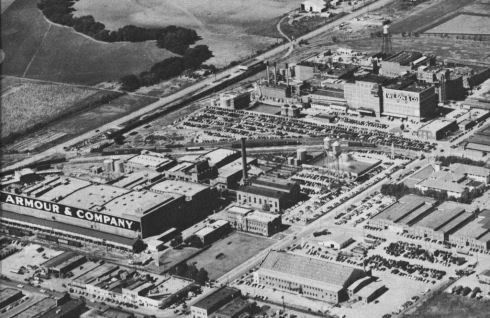
Credit mmm at OkcTalk.com for this image showing relative locations in the above ...
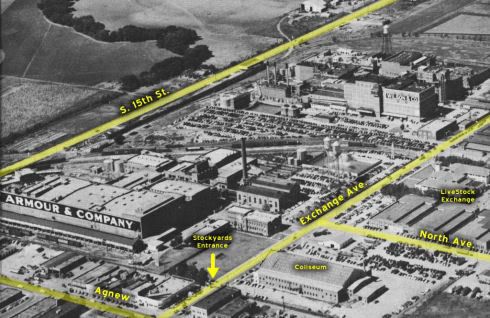
Ms. Shirk's 1957 book said,
Since 1910 the doors of Oklahoma City's two major packing plants have never been closed. Not even the depression years pinch [or] halt production.That would soon change.
TIMES CHANGE. Armour & Co. cut back its operations in 1958 and was the first meat packer to close, in 1960, when faced with the necessity of almost completely renovating its plant. Wilson & Co. would modernize in 1964, but it, too, would come to an unhappy end, in 1992.
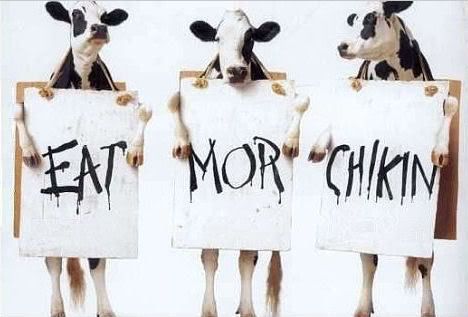
STOCKYARD CITY TODAY. An interesting article by Max Nichols in the June 22, 1998, Journal Record, Start of a Dream, gives some background. In the article, Jeanette Ainsworth Bode, who opened the Westgate Gallery in September 1997, reflected on her identification with Stockyards City. Although the gallery no longer exists (and the former space is now occupied by the Oklahoma Beef Council – see a pic below), the article nonetheless tells a story worth remembering. At the time the 1998 article was written ...
Jeanette owns the historic building that houses the WestGate Gallery at the southwest corner of Exchange and Agnew avenues. It was owned by her grandfather, Neal Ainsworth, and her father, John Ainsworth, going back to 1910. The family also owns the Langston's Western Wear building across the street. In addition, her maternal grandfather, Dan Lackey, was influential in bringing the first meat packing plant to what became Stockyards City. He later served as president of what is now the Oklahoma National Stockyards for about 25 years. "I wanted to open a gallery that would show off the works of Oklahoma artists," Bode said, "because we have outstanding artists in Oklahoma, and people visit Stockyards City from all over the world. I also want to develop a Stockyards City historical society with a museum to tell visitors about its unique history. "Visitors come here from all the world to see the National Stockyards (now the largest of its kind in the country), but there is no place to tell them how this city was built. Visitors want to know how this happened -- why Stockyards City is here." * * * She also is helping a Main Street program develop a walking tour of the preserved frontier town, and there is even talk of replacing the old Stockyards Coliseum. * * * The background of all this goes back to the 1889 Land Run. Neal Ainsworth made the land run at only 16. He had to have his claim registered in the name of his older sister, Jeanette Ainsworth. Dan Lackey, once a John Deere Co. agent, became mayor of Oklahoma City and helped form the first delegation that went to Chicago to bring the meat packing industry to Oklahoma City. City leaders raised more than $400,000 to buy a 575-block of land. Lots in the area were sold to raise another $300,000, and a separate city was formed. By 1910, two packing houses were here, and Neal Ainsworth owned the building at the southwest corner of Exchange and Agnew. * * * In about 1988, she joined an effort to get the National Trust for Historic Preservation to form a Main Street program in Stockyards City. It became the first Urban Main Street program, but Bode's dream eluded her. "My primary interest was in starting a historical society," she said, "but I was told that economic development had to come first -- that we couldn't have two forces competing for money. So I went along with it." * * * While the historical society had to wait, Jeanette and Al Bode both worked with the Main Street development. When the old Charter Club, a notorious bar, was closed in John Ainsworth's building during 1992, it was replaced by a gallery. When problems with the gallery developed, Jeanette Bode decided to start her own. The result was WestGate. * * * Bode sees the endless stream of trucks bringing cattle to auction at the stockyards early every week and wonders why people don't realize it. She sees cattlemen and other visitors enjoy the legendary Cattlemen's Cafe and shopping for western wear or for highly crafted boots, saddles and hats, and she sees opportunity. "People come here," said Bode, "but there is nothing for them to do, though the history of Oklahoma is right here."Even though WestGate Gallery apparently no longer exists, the aspirations of Jeannette Ainsworth Bode remain in place through others.
Added to the National Register of Historic Places register in 1979, the Stockyards City Historic District is described there as "An irregular pattern along Agnew and Exchange Aves., Oklahoma City (220 acres, 19 buildings, 1 object)."
The following pics were taken in Stockyards City on June 23 and June 25, 2007.
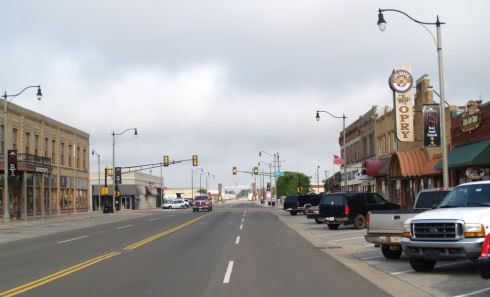
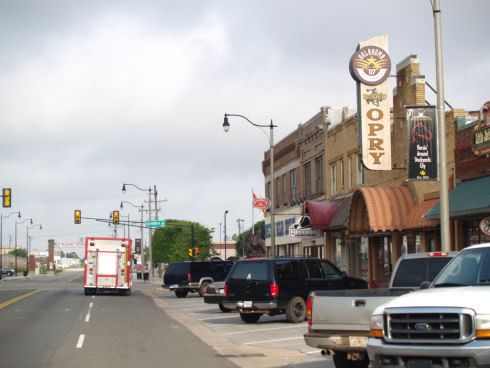
Monument at Northwest Corner of Agnew & Exchange Avenues
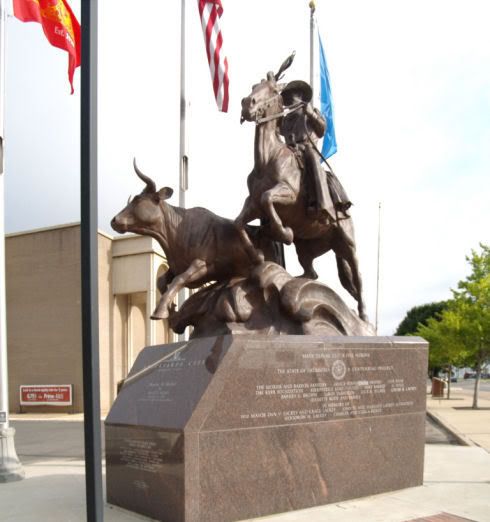
Looking Southeast at Northwest Corner of Agnew & Exchange Avenues
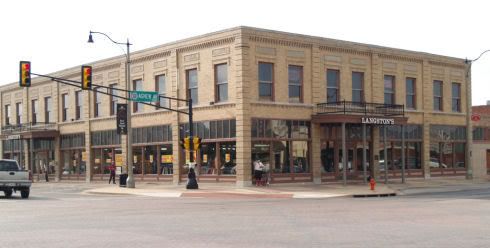
Looking South From Agnew & Exchange Avenues

Cattlemen's Cafe
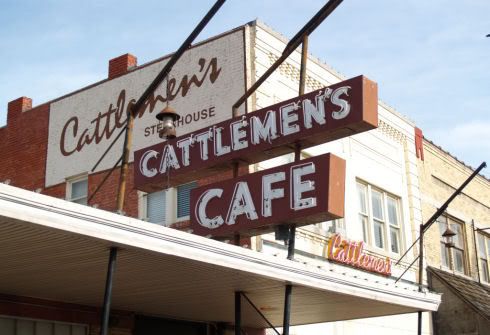
Inside A Shop Next Door To Cattlemen's
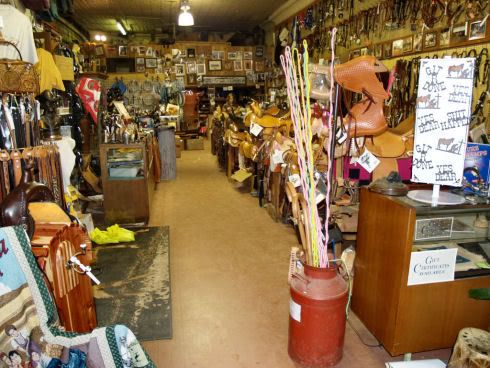
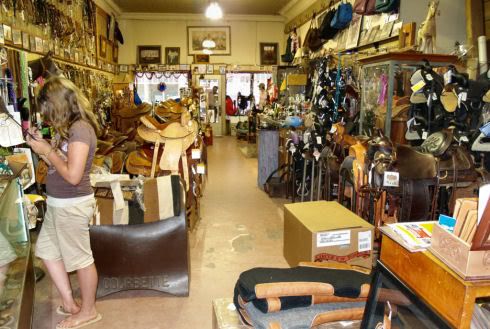
On the Corner of Southwest 13th and Agnew

Across The Street From Cattlemen's

On Exchange West of Agnew Looking South
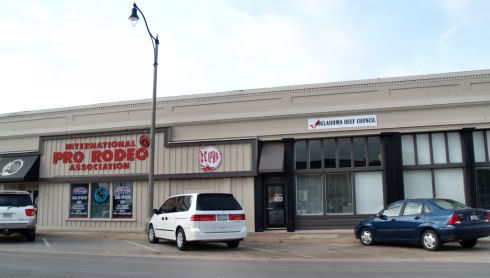
On Exchange Looking West Into The Oklahoma City National Stockyards
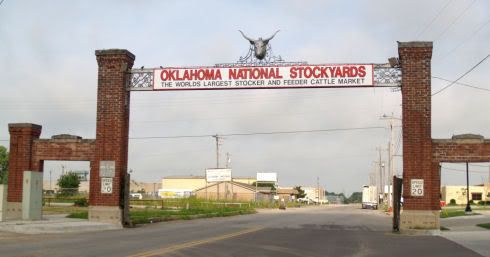
THE STOCKYARDS TODAY. Despite the loss of Wilson & Armour, the Oklahoma City National Stockyards boasts that it is the world's largest Stocker and Feeder Cattle Market. The pic below is a Google satellite image taken a few years back.
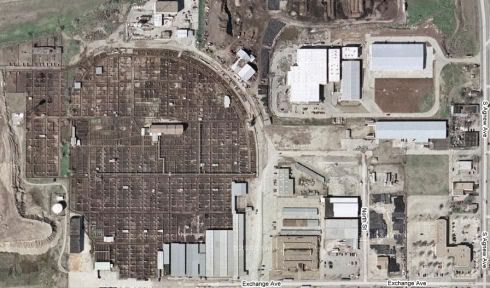
On Exchange Looking Westerly at Fairly New, But Empty, Retail Areas
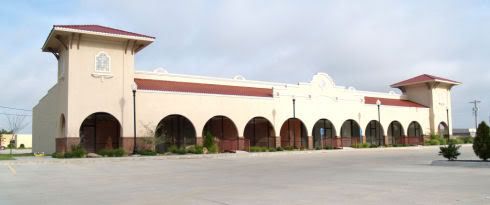
On Exchange Looking South at the Oklahoma Cattlemen's Association Building
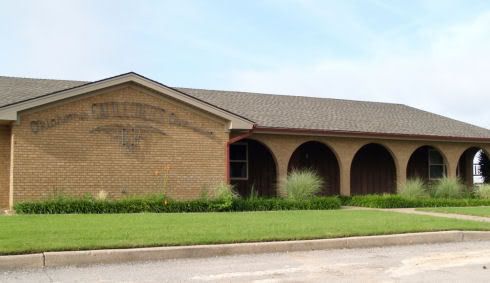
On Exchange Looking North at the Oklahoma National Stockyards Livestock Exchange Building

THE WILSON SITE. These days, the area is barren turf. Wilson, per se, ceased operations in 1992. A consortium of former Wilson managers acquired it, but in the property was quickly acquired by an Oklahoma City based firm, Bake Rite. But, Bake Rite was acquired by a New York firm, Doskocil, in a hostile takeover, but Doskocil went through a Chapter 11 Bankruptcy ... or something like what I've just said ... I may have the details incorrect. But, the bottom line is that Wilson & Co. and its successors in interest closed shop in Oklahoma City in 1994.
A June 23, 2006, Oklahoman article by Richard Mize is the last information that I've found about the property ... "Industrial Park Planned On Plant Site." The article says that the investors planned to "knock down the four buildings – one of them dating to 1910 – and develop the area as an industrial park."
Did that happen? It doesn't seem so ... these are pics taken on June 23, 2007, which show the "progress" ...

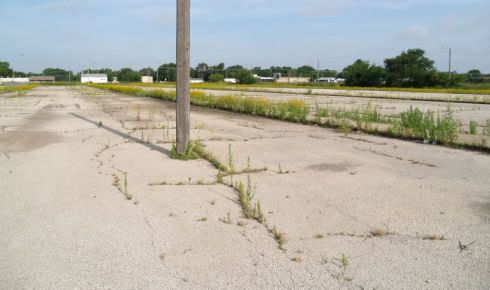
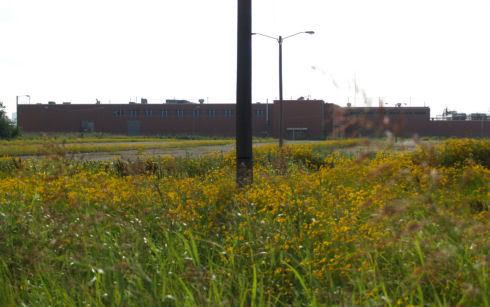
ADDITIONAL RESOURCES.
"Stockyards City" Booklet. The "Stockyards City Main Street" office next door to Cattlemen's makes available a reprint of a very nice article written by Carol Holderby Welsh in Chronicles of Oklahoma (Oklahoma Historical Society 1982).
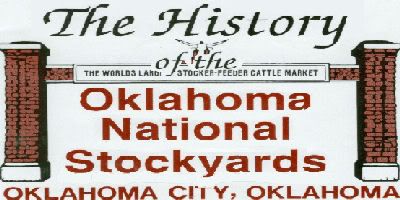
The article is limited to the development of the meat packers and the Oklahoma National Stockyards between 1910-1982 and doesn't cover much else (such as related developments in Stockyards City, e.g., businesses, gambling, booze, etc.) but it does thorougly trace historical developments as to the Stockyards, Wilson & Co., and Armour, in a matter-of-fact sort of way, more than has been done in this post.
I've scanned Stockyards City's booklet and it's a good read if what you're looking for is detailed development of the Oklahoma National Stockyards, Wilson, Armour, etc. But, don't look for any "vice" stories in the article ... they are not there. A few nice historical images are shown, however. Either click the above image or click here to open Stockyards City's nice booklet. I've set it up so that it should print well in your web browser.
Other Web Resources.














12 comments:
Very interesting, Doug, but it omits one of the most major events to happen in Stockyards City. That was in December of 1961; I don't remember the exact day. The cooling tank atop the 9-story (as I recall) Wilson plant collapsed, and it plunged all the way down, effectively gutting the plant.
Fortunately it happened on a weekend and only a minimal crew of workers were in the building. However it gave the OKC emergency system a real workout. The lessons learned from this incident, and the improvements made in our infrastructure, may have helped us be prepared for April 19, 1995...
You can probably find out more details by checking the Oklahoman's archives...
Thanks, Jim. I wasn't aware ... but will check it out and amend the post. Your comment is much appreciated!
Thank you so much this was interesting! I'm going there tomorrow
I worked for my uncle Jack Cornett at his packing plant in the mid 1970's. I never knew that packin' town was out of city limits I guess that's how we never got in trouble for shooting the pigions that tried to eat all of the feed off of the feed lot. We would work all morning quartering beef halves and loading them on trucks then after the trucks were loaded Jack would have me and my cousin Paul Edward go out and shoot pigions. The bums would come up from the river, collect all of the pigions and cook them up for dinner. I never tried it, but they just loved eating those pigions. Those were good times. Thanks Doug for keeping our history alive.
Well, now, that's funny! Maybe the subtitle for this post should be, "Eat More Pidgeons!" I've heard that people did that but, like you, have never been tried it myself ... ha ha ... never likely will! Thanks for the nice historical anecdote, a fun contribution!
To the Anonymous who said they worked for Jack Cornett...My Mother, Margaret did too...close to the same time you did...think she quit in the early 70's...
Great stuff! I'm a former OKC resident. Some of my fondest memories are going to see the wrestling matches Friday night at Stockyards Coliseum. I still try to hit the Cattleman Restuarant when I'm in town.
Thank you, Doug
Thanks for the great work you do in these pages...
Growing up in Capitol Hill from '47on I was well aware of the smell from "packintown." But, for thousands of good hard working families, that odor was the 'smell of money.' Thousands worked (hard, tough work) at the plants, made good wages and provided a good middle-class living for us 'baby boomers.' So many good jobs gone...
My dad worked for Wilson & Co. from 1950 until his retirement in 1983. The 'new' Wilson & Co. plant opened sometime around 1962. But the collapse of a brick wall inside the Armour Company plant happened on Good Friday, 1959 or'60My most vivid memories of that were listening to updates on the radio from home because my dad, uncle, and fellow employees whom I know well were all part of the rescue and clean up. Thanks for allowing me to share the memories.
Thanks much, Anon, for sharing your memories.
My dad who is now 76 remembers the collapse very well. He carried about 50 dead bodies out. We stood wondering if our dad was one who had died. Ominous for us. He said (he knows all the names) that 2 men had been in the elevator and it had large beams on them and the men were begging someone to hit them in the head and get their pain over with. Even the rescuers could not lift the heavy beams at the time but one man was able through adrenalin strength to lift them. They later died a few months afteward of amonia poisoning. I would love to find articles about this in the archives of the Daily Oklahoman if anyone has any information about it I would appreciate it. My dad is Jack D. Cook and I am Vickie Cook Senn. Thanks for your article.
Apparently, the Wilson's plant collapse occurred on March 24, 1959. The Headline read:
5 Dead, 16 Hurt in Wilson's plant. 2 Still missing.
http://goo.gl/r0P21b Page I
https://goo.gl/3LHNtU Page II*
The last total of the injured put it at 7 dead and 14 injured.
http://goo.gl/Q48h1K
On August 21, 1961 the Armour plant errupts:
4-Story Armour Building Burns; Loss $75,000
http://goo.gl/aXuWEV Page I
http://goo.gl/G1yrJ7 Page II
*Sadly, it seems the Oklahoman is slipping. The second page of the article is not linked from the first, AND trying to link the second page returns an error that this article is not available. If the Oklahoman will fix this, I will be happy to take the photo reproduction of page II down.
Wesley Horton
Post a Comment